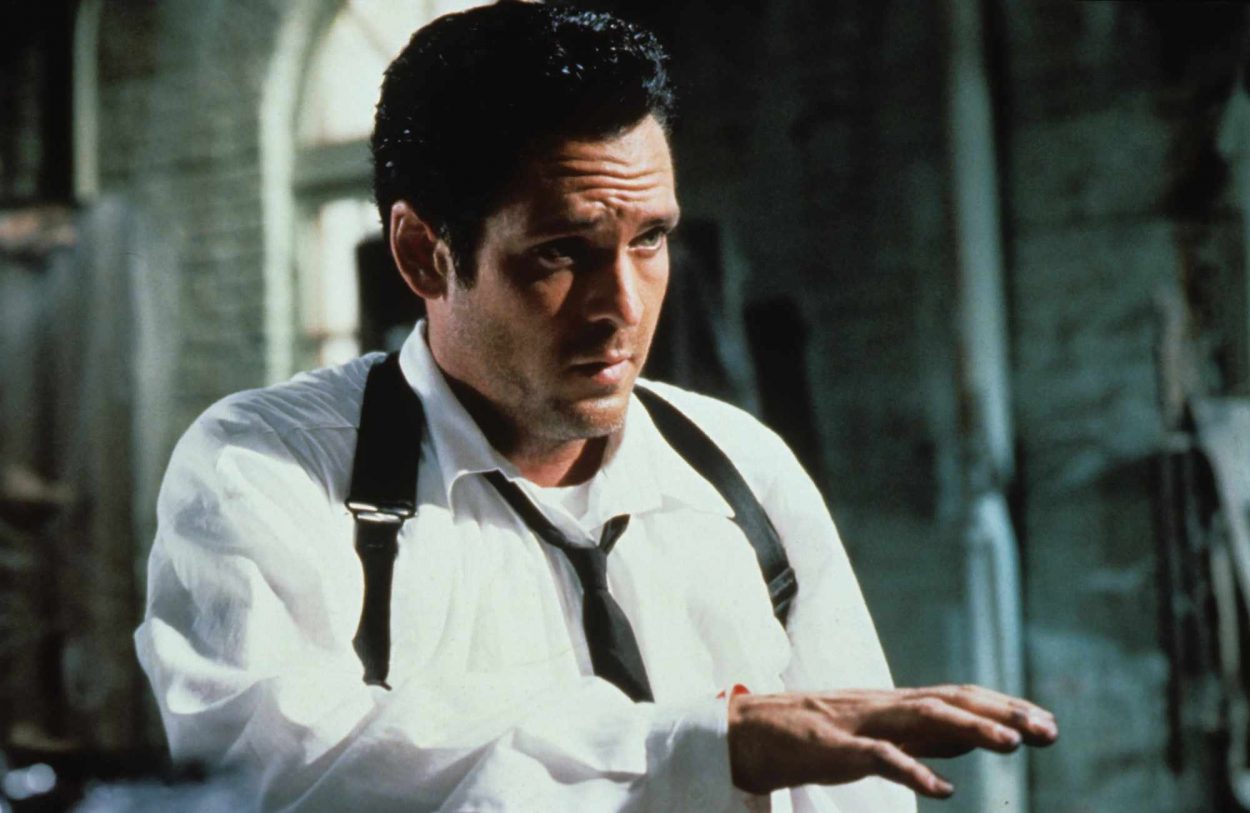Looking down from the ceiling of a lavish hotel suite within the Lexington Hotel, The Untouchables opens on a round-faced Capone, pampered and catered to as he sits in a barber’s chair that suggests a kingly throne, and De Niro embodies him from the moment he begins speaking Mamet’s exquisite dialogue. In an era when newspaper presses shook buildings and the news of Capone’s prohibition criminal empire shook Chicago, the reporters he so easily charms with his faux friendliness and bootlegging philosophy, eagerly write down his every word as if they were documenting a misunderstood philanthropist, instead of a murdering gangster – “On a boat it’s bootlegging, on Lakeshore Drive, it’s hospitality.” He emphatically denies any violence perpetrated by him or the people he employs, “because it’s bad business.” Outside under the “el” Chicago circa 1930 comes to life in the daylight, and what better way to juxtapose what a duplicitous, evil adversary Capone and his men are, than to blow up the corner café and a cute pig-tailed girl trying to return a briefcase to the white suited, remorseless hit man Frank Nitti (played with cold blooded perfection by Billy Drago). Nitti leaves the briefcase bomb after he and another of Capone’s men are rebuffed in their efforts to sell some “green beer” to the café’s owner and the message is clear, play ball with Capone, or take a stand and die a violent death. It is indeed the time of Capone.
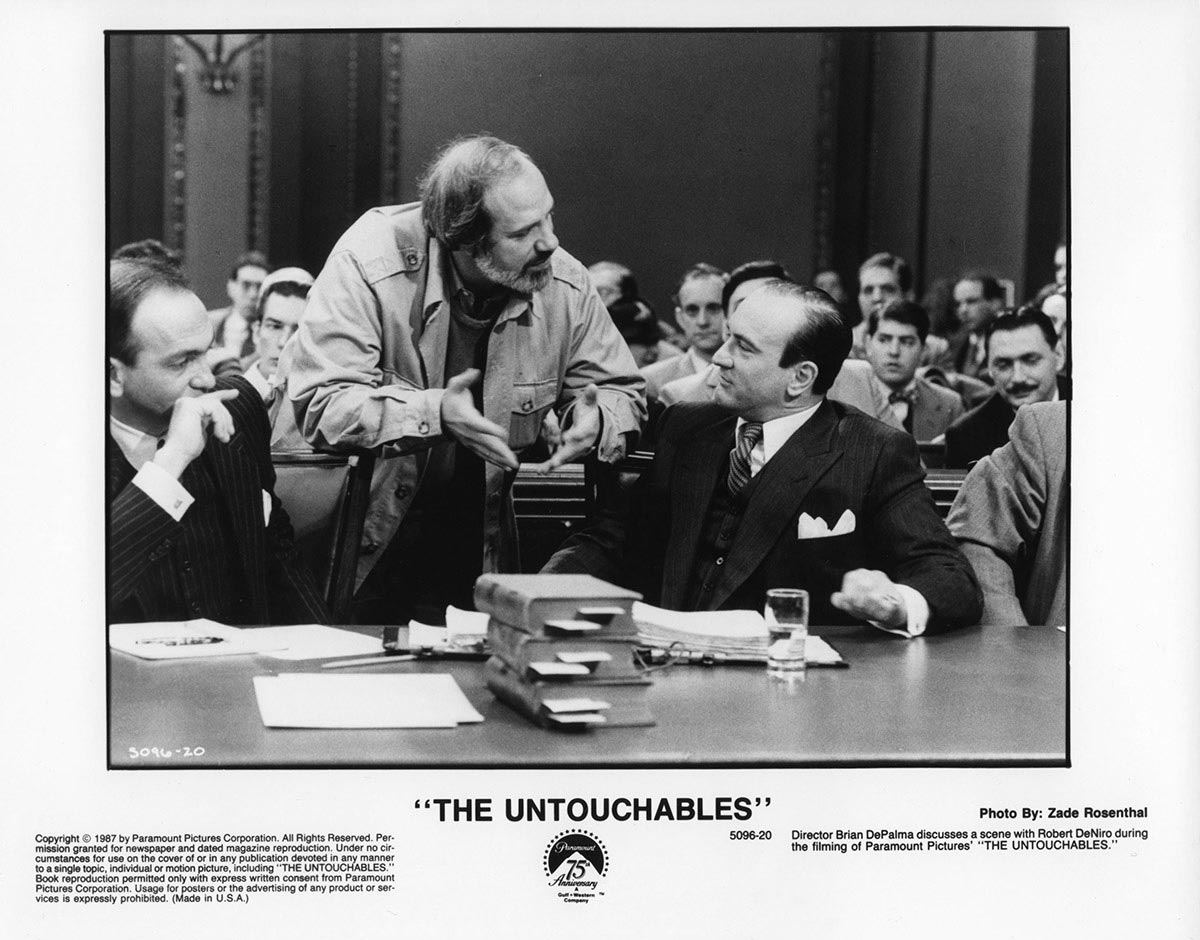
Brian De Palma was ripe for a hit movie within the studio system when he was contacted by producer Art Linson to discuss directing The Untouchables. De Palma had honed his talents as both a writer and director, having cut his teeth with interesting, avant-garde films beginning in the 60’s with Murder a La Mod (1968), gained momentum with his comedy-horror-fantasy-musical-romance-thriller Phantom of the Paradise (1974), and had an outperforming success given the films small budget with the horror classic Carrie (1976). His unique voice that was emerging early in his career had matured into a distinctly recognizable style by the time the studios came calling, and while he was garnering a reputation as a “master of suspense” with The Fury (1978), Dressed to Kill (1980), Blow Out (1981), Scarface (1983) and Body Double (1984), he had never enjoyed that blockbuster film that Variety displayed one page congratulatory ads for. Armed with one of playwright and screenwriter David Mamet’s greatest screenplays, De Palma’s stylized artistry would take the old cops and robbers genre to new heights with a movie that in his own words – “was one of those rare films that worked from the get-go.”
De Palma doesn’t just recreate prohibition-era Chicago, he transports us back to it. While historical accuracy often takes a back seat to artistic license in this 1950’s-television-show-blown-up-to-a-big-screen masterwork, the use of practical locations within the City of Big Shoulders breathes a life into the film that make the architecture supporting characters lording over the scenes. When you look at some of the great crime films of the 1980’s that centered on the heroes with badges tracking the bad guy in movies like Friedkin’s To Live in Die in L.A. or Michael Mann’s Manhunter, these movies had a tough guy, street-smart investigator that had been around the block, while The Untouchables featured a do-gooder in Eliot Ness whose lofty ideals in taking down Capone are rooted in morality instead of reality. Ness is no Popeye Doyle character that would turn the law on its head to get his man, he’s a hero whose journey is to change into someone that’s experienced enough loss at the hands of Capone and his men, that he can sit in at the big table and play back at these bootlegging bastards – using the violence necessary to achieve justice in this high-stakes game where there are no rules.
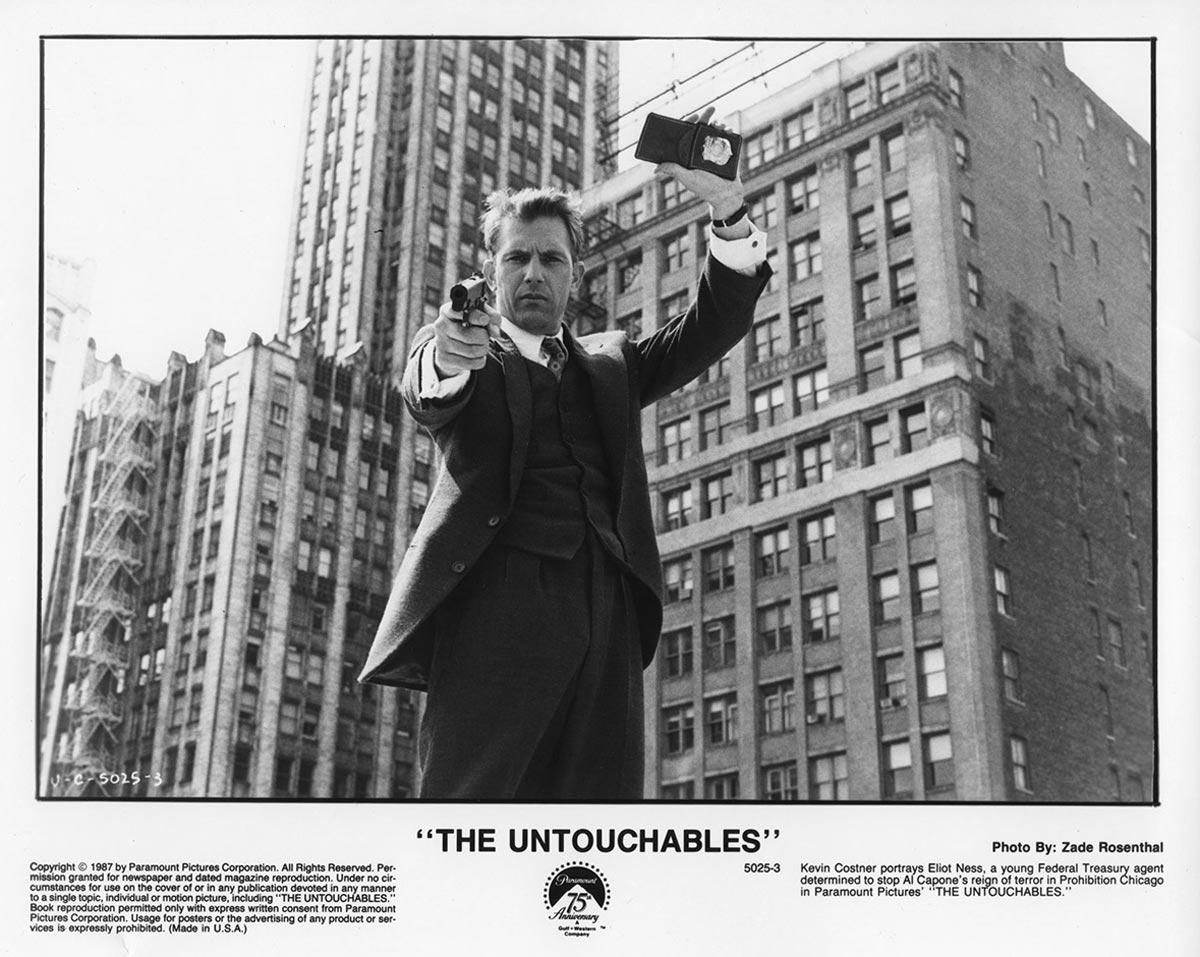
After Paramount Studios and producer Art Linson told De Palma that stars wouldn’t be necessary and that he could cast whomever he wanted, Kevin Costner was perfect as a relative unknown to play Ness, all earnest and eager with the handsome visage of a movie star, and the relatable likability of Jimmy Stewart. Andy Garcia, after balking at De Palma’s invitation to read for Frank Nitti, lobbied for and won the role of cracker jack marksman and young Treasury Department recruit George Stone (aka Giuseppe Petri). Rock solid character actor Charles Martin Smith, who made his big screen debut in The Culpepper Cattle Company (1972), was perfectly cast as accountant Oscar Wallace – a key figure in taking down Capone – by discovering that the gangster was guilty of tax evasion.
Mamet brilliantly tackles the film’s biggest obstacle in “Nancy-boy Eliot Ness” and his lack of experience, by constructing a storyline that would require a mentor to teach Ness and his men “the Chicago way,” and Sean Connery as Irish beat cop Jim Malone was an essential piece of casting that anchored the film. Malone has the savvy of a “seen it all” veteran, and wants no part of the payola corruption his fellow police officers enjoy in Capone’s Chicago – dropping knowledge on the enthusiastic, but green Elliot Ness – “you just fulfilled the first rule of law enforcement: make sure when your shift is over you go home alive.” Malone is just as hell bent on fighting the police corruption in the precinct he works for, as he is in busting Al Capone, and since the two go hand in hand, he begins to look for the right men for the job in a sort of Seven Samurai, Magnificent Seven (albeit four) recruitment – knowing it all hinges on a tight knit group that are more incorruptible than untouchable. Desperate for a win after the team’s first effort to get Capone ends in front page news humiliation – “Let’s do some good!” – Malone takes the team to the Post Office for an unannounced raid that crooked cops can’t tip off, much to the confusion of Elliott Ness – “Mr. Ness, everybody knows where the booze is. The problem isn’t finding it, the problem is who wants to cross Capone?”
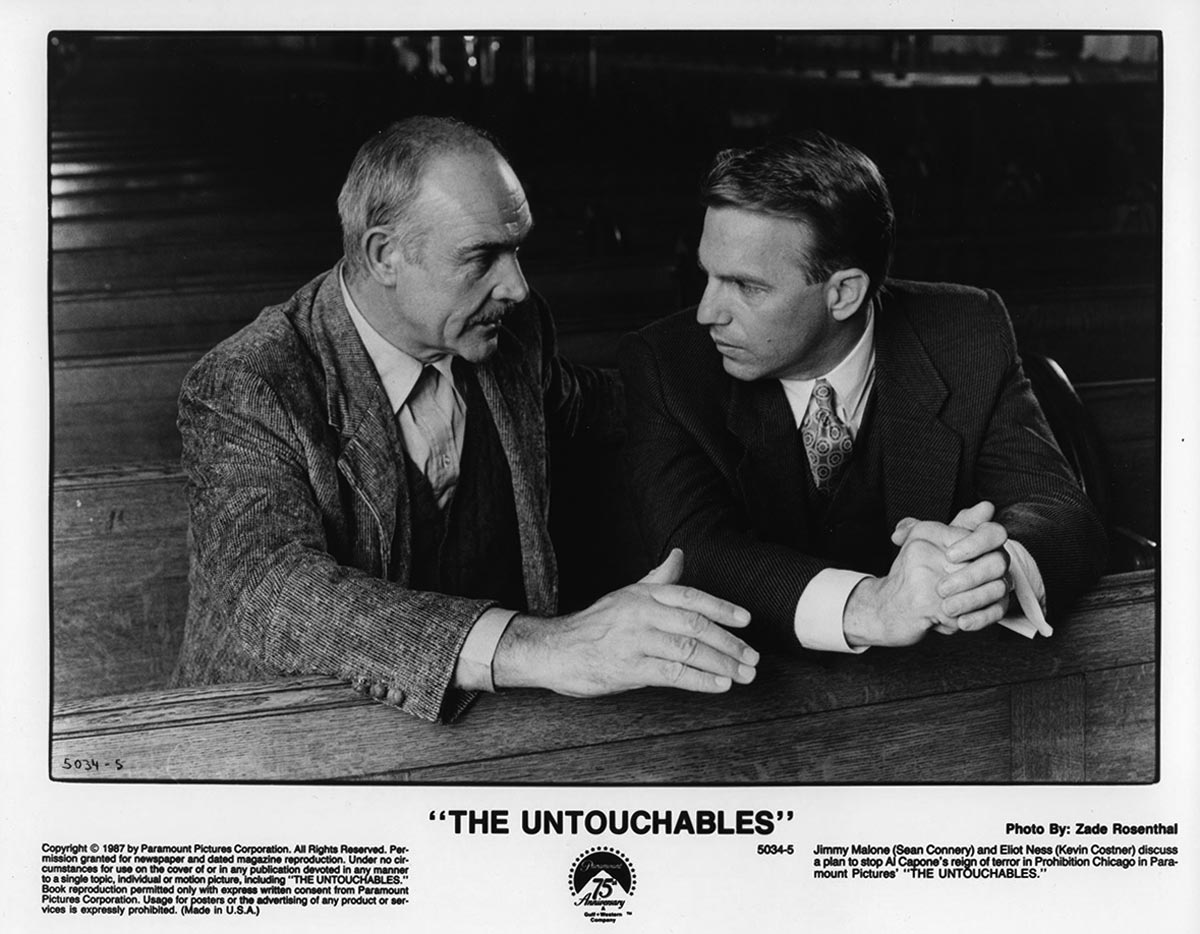
Bob Hoskins was initially signed on to play the role of Capone, since De Niro’s schedule proved unavailable, and Hoskins certainly bore a striking physical resemblance to the gangster, with memorable roles in the 80’s crime films The Long Good Friday and The Cotton Club. As the movie was preparing to begin production and De Niro could suddenly accommodate the shooting schedule, De Palma told the studio he wasn’t prepared to make the film without De Niro in the role of Capone. At a time when the studio was asking De Palma to cut out a million dollars from the film, he was instead telling them the budget could not only not be cut, but would have to be raised in order to accommodate De Niro’s high salary demands. Linson credits De Palma’s game of chicken with Paramount for landing an artist of De Niro’s stature, but when DeNiro showed up for his meeting with De Palma and Linson, he was rail thin after having just completed his role as Louis Cyphre (Lucifer) in Angel Heart. A panicked Linson voiced his concern to De Palma that this was no Al Capone and they had to go with Hoskins, but De Palma explained that in the three months De Niro had to prepare for the part, he would return transformed, and transformed he was – smirking, battering, taunting, mocking, and snarling his way through his scenes. It’s remarkable to think that in a three-picture span from 1987-1988, De Niro played the devil, Capone and bounty hunter Jack Walsh in Midnight Run. The studio payed off Hoskins and De Palma had his Capone, marking the fourth film the two would collaborate on, providing the final piece of the casting puzzle.
With the perfect cast in place to bring the story to life, De Palma was free to use his signature visual storytelling mastery, using long takes and his trademark-Hitchcock-influenced “creeper” sequence – shot from the killer’s point of view who is stalking the victim but doesn’t want to be seen. While the hand-held creeper sequence devoid of dialogue is always highly effective in the De Palma filmography, none evokes the emotional impact like the one that takes us through Jim Malone’s modest apartment – the climax of which solidified Sean Connery’s name on his Best Supporting Actor Academy Award. It’s a show stopper, and the most important lesson that Costner’s Ness needs to learn. The kind of lesson that Malone was trying to impart to Ness in the famous church scene that director of photography Steven H. Burum shot from a low angle, making the two men appear larger than life, overwhelming the screen as Malone prods Ness – “What are you prepared to do?” Ness’s answer – “Everything within the law,” will fall woefully short to bring down Capone. The irony of the bloodshed that Malone forewarns will be the result of Ness’s crusade, while the two men speak of violence in a house of God, was a set location suggested to De Palma by Connery himself. This connection to the material was a perfect example of the veteran actor shepherding the characters not only onscreen, but off-screen as well.
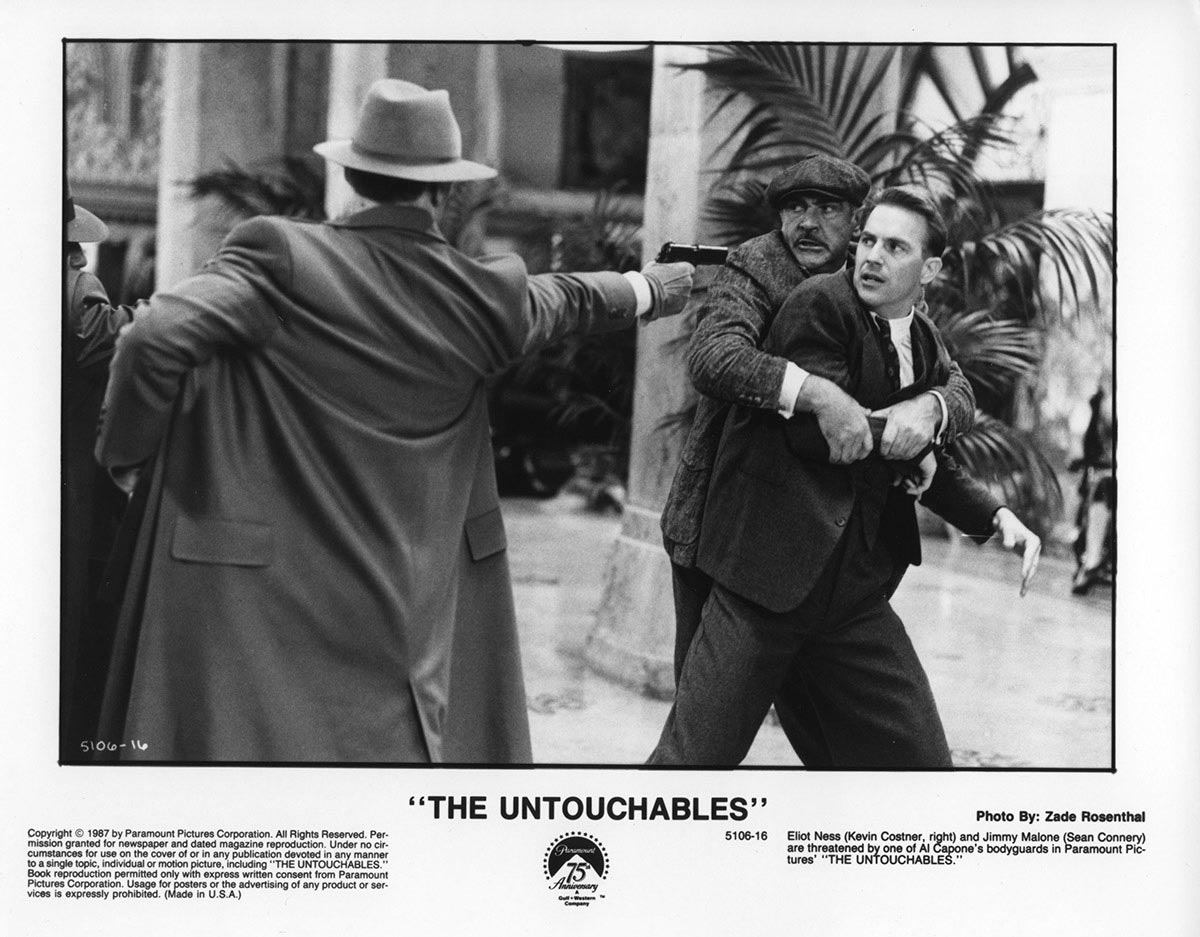
Burum originally wanted to shoot the film in black and white, but after De Palma explained that the studio would never go for that, he instead came up with a “compositional plan to shoot repetitive images.” In a kind of Kubrick-esque pattern, he set up shots with the same make of car lined up in identical formations on both sides of the street, creating a sense of period familiarity without overwhelming us with colors and busy sets. Burum also employed framing with a lot of “negative space” to remind the audience that things were still evolving, and there weren’t as many people jammed together in an urban environment like there was 30 years ago when the film was first released. Location Scout Eric Schwab and Visual Consultant Patrizia von Brandenstein return Chicago to its prohibition history, with essential locations that keep us in the film’s time period. The two were key contributors to the authenticity of the film’s period look, and put the green screen and computer mate backgrounds of today’s movies to shame.
When the production couldn’t afford to bring to life Mamet’s train collision at Union Station as it appeared in the script, De Palma shows off a bit, crafting the Odessa Steps homage from Sergei Eisenstein’s Battleship Potemkin (1925), forcing Costner and Garcia to deal with a baby carriage and its tiny passenger as it makes its way down the Union Station stairs, while they are engaged in a gun fight with Capone’s men. De Palma knew that it’s one thing to blow a cute girl with pig-tails to smithereens, but it’s something else all-together to have a baby killed. Who says De Palma films are too violent?
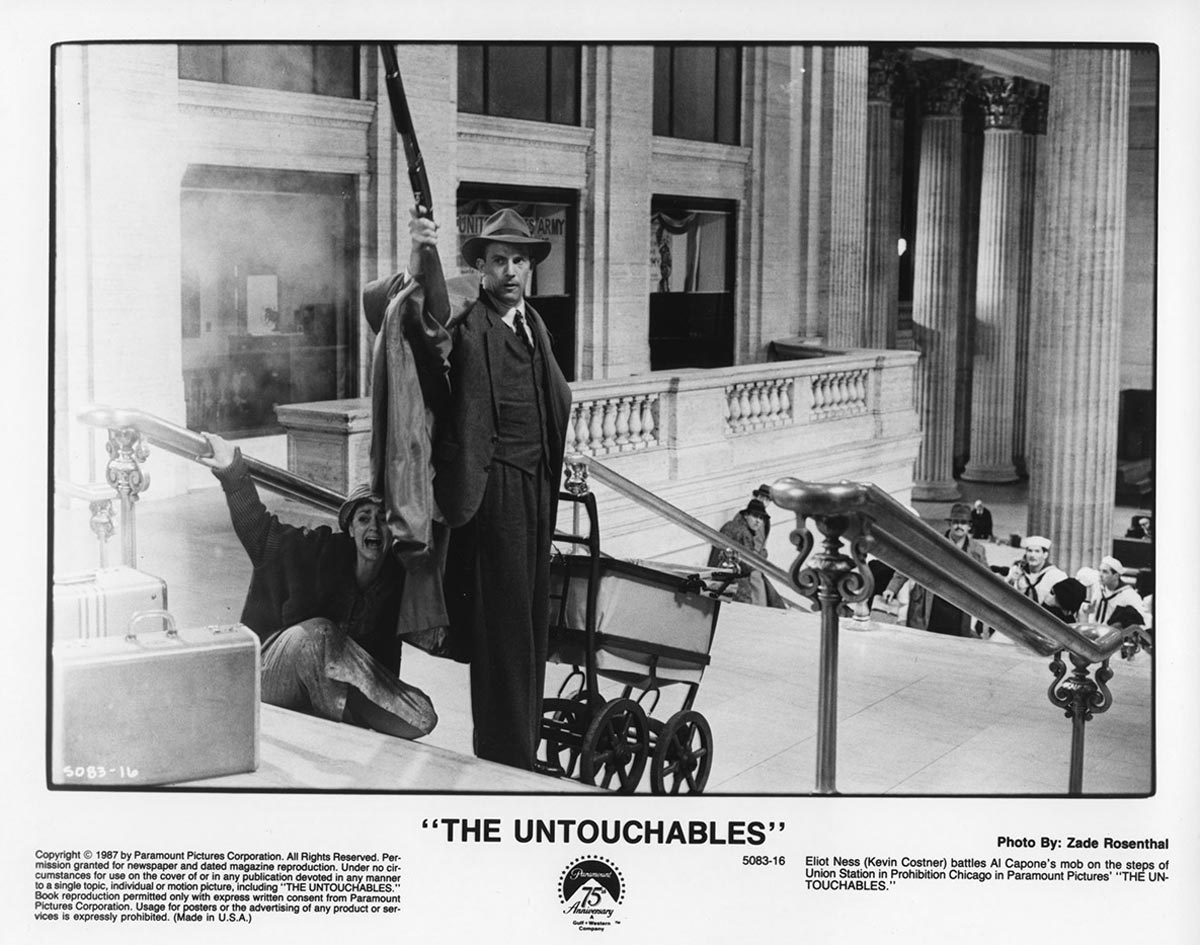
De Palma and Mamet created an opera with De Niro as a cherubic “Pagliacci” character that is both jester and royalty, and no opera is complete without costumes to enhance the story and the music that tells it – with Marilyn Vance nominated for Best Costume Design (Vance always took exception to the Armani credit) and Ennio Morricone nominated for Best Original Score. For all the film’s smart camera moves, genre raising script, slick production design, and standout performances, the key to the film is Morricone’s score. The sweeping music lifts you out of your seat, while the driving intensity pins you to it. His five note piano march builds suspense while the sharp notes of his haunting, hair raising harmonica, informs us that something wicked is lurking, and on a dime Morricone turns the Post Office raid into a pride filled victory for Ness’ crew, with a colorful musical exclamation mark of what would’ve otherwise been a simple scene unto itself. It’s incredible work by the genius composer.
The Untouchables is a handsome, incredibly satisfying film experience, that continually one-ups itself, and even the violence has a brilliant polish to it we can’t turn away from. The film sits on De Palma’s Mount Rushmore, remaining every bit as stylized in the crime genre as Tim Burton’s Batman that followed in 1989, or the comic book color palette of Dick Tracy in 1990, ranking among one of the decade’s finest crime films.

